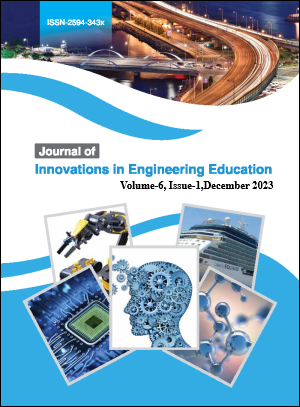Evaluation of thermal performance in Pulsating Heat Pipe cooling system
DOI:
https://doi.org/10.3126/jiee.v6i1.61098Keywords:
Computational Fluid Dynamics, Numerical modeling, Thermal Resistance, Pulsating Heat PipeAbstract
The effectiveness of the pulsating heat pipe’s is one of many concerning factor in accessing thermal
performance is contingent on various physical parameters, namely diameter, length, numbers of turn, heat
inputs, and fill ratios of the heat pipe. Both experimental and numerical modeling approaches were
employed to investigate a single-loop heat pipe, aiming to determine the thermal resistance at fill ratios of
40%, 50%, and 60% for water. This investigation was conducted under conditions of fluctuating
temperature inputs, specifically at 378K, 383K, 388K, and 393K. The experiment was conducted for a
copper pipe of inner diameter 4.0625mm and, at the evaporator heat input was supplied 45W. It was found
experimentally that the thermal resistance was lowest for the case of 60% FR at 393K (i.e., 0.762K/W) after
all the systems were stable but initially at the startup phase thermal resistance was lowest for the case of
50% at 393K (i.e., 1.279K/W). The analysis through numerical simulation included the examination of the
temperature variation between the evaporator (T e ) and condenser (T c ), thermal resistance (R th ), the pulsating
nature of the heat pipe, phase change of the working fluid, and fluid flow behavior. The thermal resistance
obtained through numerical modeling is found to be lowest for a 50% FR at 393K (i.e., 1.032K/W) which
resembles the initial startup phase. To confirm the occurrence of a two-phase phenomenon inside the PHP,
the volume fraction of water in evaporator region was obtained from simulation results and was plotted
against the time step. Observation of the oscillating motion in the PHP was conducted through a numerical
model and affirmed by the upward movement of the vapor bubble toward the condenser, as well as the
velocity vector contour at a specific cross-section of the pipe. The fluctuation in temperature observed in
both the evaporator and condenser provides evidence that the liquid and vapor slugs oscillate along the
pipe, facilitating the transport of heat from evaporator section to condenser. This experiment suggests that
the best case within the tested working condition is for a 60% FR at 393K.
Downloads
Downloads
Published
How to Cite
Issue
Section
License
Copyright (c) 2023 JIEE and the authors

This work is licensed under a Creative Commons Attribution-NonCommercial-NoDerivatives 4.0 International License.
Upon acceptance of an article, the copyright for the published works remains in the JIEE, Thapathali Campus and the authors.

